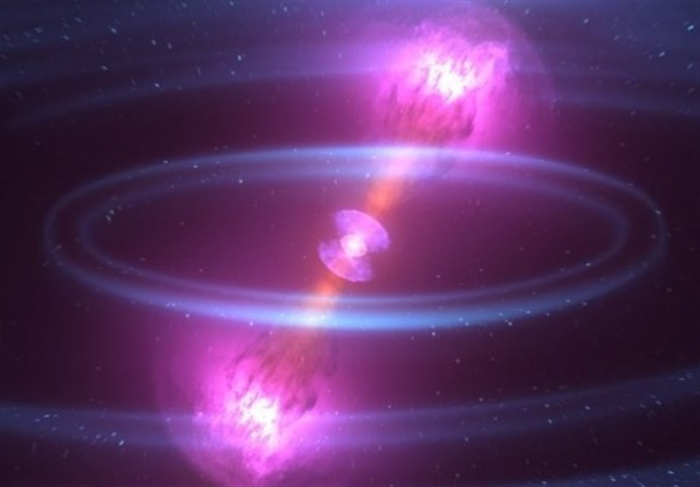A violent collision between two neutron stars 4.6 billion years ago showered the as-yet-unformed Solar System with heavy elements, new research has found.
As much as 0.3 percent of Earth's gold, platinum and uranium (along with other heavy elements) could have been forged in the fire of a merger 1,000 light-years away, when the Solar System was little more than a cloud of gas and dust, Science Alert reported.
"This means that in each of us we would find an eyelash worth of these elements," said astrophysicist Imre Bartos of the University of Florida, "mostly in the form of iodine, which is essential to life."
The famous neutron star collision detected in 2017 taught us many things - not least of which is that such collisions produce heavy elements. In the electromagnetic data produced by GW 170817, scientists detected, for the first time, the production of heavy elements including gold, platinum and uranium.
This is because a powerful explosion, such as a supernova or stellar merger, can trigger the rapid neutron-capture process, or r-process - a series of nuclear reactions in which atomic nuclei collide with neutrons to synthesise elements heavier than iron.
The reactions need to happen quickly enough that radioactive decay doesn't have a chance to occur before more neutrons are added to the nucleus, which means it needs to happen where there are a lot of free neutrons floating about - like an exploding star.
To figure out where Earth's heavy elements may have come from - whether a supernova or a neutron star merger - Bartos and his colleague Szabolcs Márka of Columbia University have analysed the radioactive isotopes in early Solar System meteorites.
These are found in actinides - heavy elements with atomic numbers from 89 through 103, from actinium through lawrencium, all of which are radioactive; their traces can be found in meteorites from the early days of the Solar System.
Radioactive isotopes have a half-life. That refers to the period of time it takes for half the atomic nuclei in a sample to decay, and it's a known quantity for various elements. Radioactive half-life can, therefore, be used as a sort of time capsule to reconstruct specific time periods.
So the researchers were able to use these meteorite actinides, plutonium, uranium and curium, to reconstruct the abundances of heavy elements in the early Solar System.
In and of itself, this doesn't tell us much more than that, so the team ran numerical simulations of the early Solar System to compare the real-life meteorite abundances against the simulations. And they found that the two didn't match up without a neutron star smash-up.
The best fit for the observed actinide abundances was a neutron star collision about 1,000 light-years from the Solar System (so, inside the Milky Way galaxy), roughly 100 million years before the Earth formed, when the gas cloud that became the Solar System was still in the process of coalescing.
"If a comparable event happened today at a similar distance from the solar system, the ensuing radiation could outshine the entire night sky," Márka said.
This event, their research found, sprayed elements out into the surrounding space, contributing 70 percent of the early Solar System's curium, and 40 percent of its plutonium. Because of radioactive decay, there is much less of it now, 4.6 billion years later.
And it couldn't have been a supernova, they found - they occur far too often, putting the actinide abundances they would produce beyond the constraints defined by the meteorites.
It's a result, the researchers said, that can shed some light on the processes that shaped the Solar System. And it has some existential significance, too.
"Our results address a fundamental quest of humanity: Where did we come from and where are we going?" Márka said.
"It is very difficult to describe the tremendous emotions we felt when we realised what we had found and what it means for the future as we search for an explanation of our place in the Universe."
More about: Earth Solar-system
















































